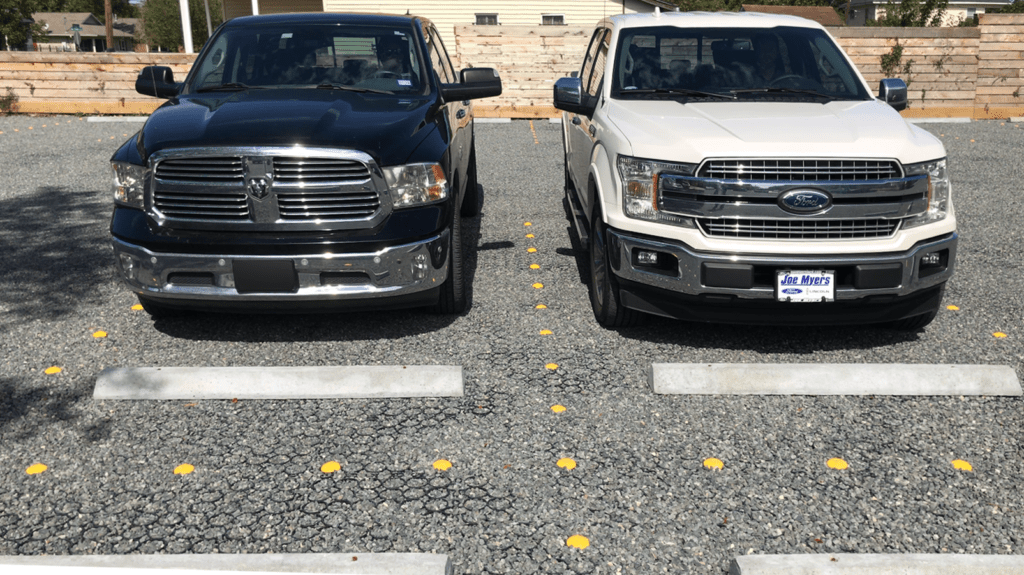Parking spaces can be found anywhere you look, in any town. Most of them are relatively uniform in their dimensions, but their size and shape can vary in accordance with local regulations and laws.

There are a number of different factors which might influence the dimensions of a particular parking space and there are plenty of considerations to be made when designing one. If you’re looking to optimize the parking spot in a variety of ways that benefit you and your community, considering all your options when designing a space is a wise choice.
In case you’re designing one or more parking spaces, let’s take a look at the average dimensions of parking spaces and how you can best design yours for optimal performance.
All About Parking Space Dimensions
What is the size of a standard parking space? The standard parking space size in the U.S. is approximately anywhere from 7.5 ft. wide to 9 ft. wide. It’s also anywhere from 16 ft. to 20 ft. deep. These parameters are enough to accommodate the average vehicle, not including longer or wider vehicles like RVs, semi-trucks, and other bigger vehicles.

For parallel parking, the size of a standard parking space is anywhere from 20 ft. to 24 ft. deep, with a traditional 7.5 to 9 ft. width. Parking lots have additional considerations to make when designing their lots.
For areas that get a lot of traffic, the parking lot must be designed to accommodate the maximum expected amount of vehicles at one time. Though, this often results in businesses designing parking lots with too many spaces that just sit empty all the time. These large lots cost even more to maintain and can require tons of additional drainage systems past a certain size, as well.

The standard size parking space can also play a role in what angle parking spaces are set at. The goals of a particular parking space can vary and the angle of said space should be adjusted accordingly. 90-degree angle parking spaces are the most common type, and they are used as a way to save space and money. They can fit the most vehicles into the smallest area, but make maneuvering much harder.
This means people will have to take more time getting in and out of the parking space and will have to drive slower as a result. This is not always a bad thing, though, and can actually be implemented as a safety measure, forcing drivers to be more careful in an area where there are people walking in close proximity to moving vehicles.

The discussion of angles adds a bit more nuance to the equation when we ask, “What is the standard size of a parking space?” There are also other common parking space angles like 30-degree angles, 45-degree angles, 60-degree angles, and straight angles.
These angles provide more room to maneuver and make sideswipes less likely as well as lessening the instance of vehicles parking too close to each other and blocking in doors.
Additional Parking Space Design Considerations
Durability and permeability are a few more characteristics of parking spaces that we often tend to overlook. This is because they are directly related to the materials used to build a parking lot, with asphalt being the primary material that most people use.

Asphalt has a set level of durability and base level of maintenance required to keep it in top shape. It also has no permeability whatsoever, which means it requires an added drainage system to manage stormwater. Concrete is the same and though there are permeable versions of both asphalt and concrete, they are costly, easily clogged, and require a lot of maintenance.
How to Build the Optimal Parking Space with TRUEGRID Pavers
The optimal parking space should be designed with its usage in mind. If you need to fit as many spaces as possible in your lot and it’s for a bigger business like a grocery store, 90-degree angles are perfectly fine. For parking lots that don’t expect as much traffic or if you just want to make things easier on drivers, wider angles are best. Straight angles are best for parking on the side of roads.

For permeability and durability, we recommend TRUEGRID permeable pavers. TRUEGRID PRO LITE and TRUEGRID PRO PLUS, for example, both make excellent choices. These pavers are 100% permeable, and they eliminate the need for additional drainage and the possibility of flooding, as well as the need for costly maintenance.
You can also use TRUEGRID SuperSpots® to mark your parking spaces and easily shift them around as you see fit. They easily snap in and out of place instantly and never need to be repainted like traditional lot lines.
TRUEGRID pavers are so durable that they can last up to 60 years with almost no maintenance required. They are eco-friendly and made from 100% post-consumer high density plastic, using grids that snap together like LEGO blocks and lock gravel into place to create a sturdy, level driving surface.
If you want to build the best, longest-lasting, most eco-friendly parking space you can while saving money in the long run, contact TRUEGRID today to get in touch with a pavement professional for a free quote.



